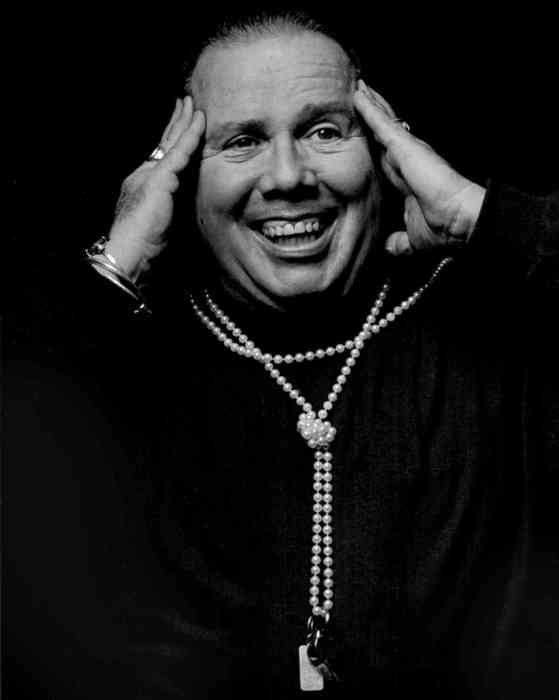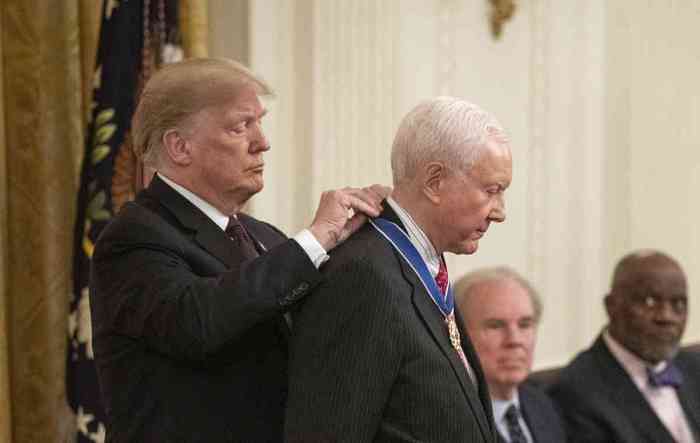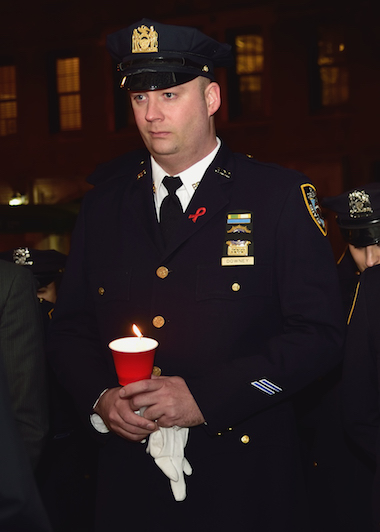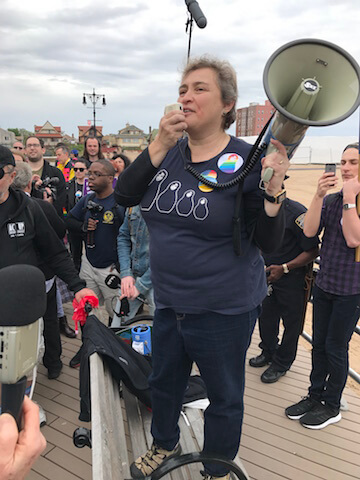Councilmember Daniel Dromm looks on as Julio’s brother Ted Rivera (l.) and Ted’s daughter Jenny hold a poster commemorating Julio. | GAY CITY NEWS
The brutal 1990 murder of Julio Rivera, 29, by three skinheads “hunting homos” in Jackson Heights was marked by an emotional vigil near the site of the killing at 37th Avenue and 78th Street, since renamed Julio Rivera Corner. More than half of the 50 people who gathered the evening of July 1 were involved in seeking justice for Rivera in a case that was initially ignored by police and prosecutors.
Ken Kidd of Queer Nation was there with his group in 1990 and back for the vigil.
“When we read about Julio being hit with the claw end of a hammer and then stabbed to death, it got people riled up,” he said. “We’d had enough. Our friends were dropping at an alarming rate from AIDS. Matt Foreman was the head of the Anti-Violence Project and he brought it to public attention.”
Jackson Heights vigil includes many who took up his cause
The 25th anniversary vigil was led by Councilmember Daniel Dromm, a gay Democrat from Jackson Heights, who was a grade school teacher in 1990 whose activism in Queens was inspired by the Rivera murder. Dromm’s activist engagement accelerated in 1992 by the opposition in his local school district to the multicultural Children of the Rainbow curriculum that included mention of LGBT families. Dromm founded the Queens LGBT Pride parade in 1993 and the Lesbian and Gay Democratic Club of Queens the following year, working ever since to keep Rivera’s name alive.
Julio Rivera, who was brutally murdered in Jackson Heights in 1990.
“If it wasn’t for Julio,” Dromm said, “the Queens LGBT movement would not have gotten as far as it has gotten. Julio did not die in vain. He changed people’s lives.”
Ted Rivera, Julio’s brother, who with his then-wife Peg threw himself into the movement for justice for Julio, said, “Twenty-five years ago we were very alone.” The way in which the Latino and gay communities in Queens came together and secured justice and built a movement made him grateful for “all the good that has come from Julio’s death.”
Ted’s daughter, Jenny, said, “We’re so grateful for everyone here. So many of you have been here from day one.”
Choking up, Dromm said, “What happened to Julio could have happened to any of us.” He said that there was no initial investigation into the murder “because Julio was seen as a throwaway” and the city would not put up a reward for information leading to arrests in the case.
Gay activist Brendan Fay, co-founder of the St. Pat’s for All Parade in Sunnyside, said, “Julio Rivera hoped to live a full life. That’s why he moved to Jackson Heights.” His death, Fay said, “took the movement out of Greenwich Village to throughout the city.”
With the vigil coming just days after the US Supreme Court had opened marriage to gay couples in all 50 states, there was much talk of the movement’s work not being over. Chai Jindasurat, co-director of community organizing at the Anti-Violence Project, said, “Our national study showed 21 people killed for being LGBT in 2014, many of them transgender, and people of color were disproportionately affected.”
The corner that commemorates Julio Rivera. | OFFICE OF COUNCILMEMBER DANIEL DROMM
Ed Sedarbaum, a Queens gay activist by 1990 who co-founded Queens Lesbians and Gays United the next year, wrote in an email, “The two things that shine in my memory [are] (1) Seeing neighbors stepping out in the first march who had never been out of the closet in their own neighborhood, and telling me how thrilling it was. One of them, Susan Caust, ended up co-chairing Q-GLU with me. The other was the behavior of the crowd after the first march and vigil in the schoolyard. As emcee, I thanked people for keeping things dignified in deference to the culture of the neighborhood, then gave them information about the safest way to get back to the subway and suggesting they walk in large groups… after which, those dignified groups of ACT UPers and Queer Nationals were joined by the fearful local residents, who en masse broke into chanting and shouting and then took over Roosevelt Avenue and stopped traffic. Partly that was just release of the tension from a long day, but I was so proud of my neighbors who, having committed themselves to the struggle, were joyously giving themselves over to the more radical temper of the times. They got it.”
Richard Shpuntoff, director of the documentary “Julio of Jackson Heights” now in the process of completion, sent a statement from Buenos Aires paying tribute to Alan Sack who “said goodnight to him on the corner” a half hour before Rivera was killed. Sack, who was not able to attend the memorial, once told Shpuntoff, “Julio was a great political victory for the community, but it came at a horrible personal price for many of us.”
Julio’s sister Rita Barakos holds the Newsday issue reporting on the original conviction of the three men charged in his murder. | GAY CITY NEWS
Matt Foreman, the executive director of the Gay and Lesbian Anti-Violence Project at the time of the murder and now senior program director for gay and immigrant rights for the Evelyn & Walter Haas, Jr. Fund in San Francisco, wrote in an email, “It’s still hard to believe all the good and enduring things that have come out of such a horrific crime. It shows what can happen when ‘mainstream’ organizations, direct action activists, and a devoted family… come together and don't give up. I know Julio would be very, very proud.”
Of the three men who killed Rivera, Esat Bici who jumped bail to avoid a retrial after his first conviction was thrown out, was himself killed in 2002. Daniel Doyle and Erik Brown have completed their sentences. But it is the memory of Julio Rivera that lives on.






































